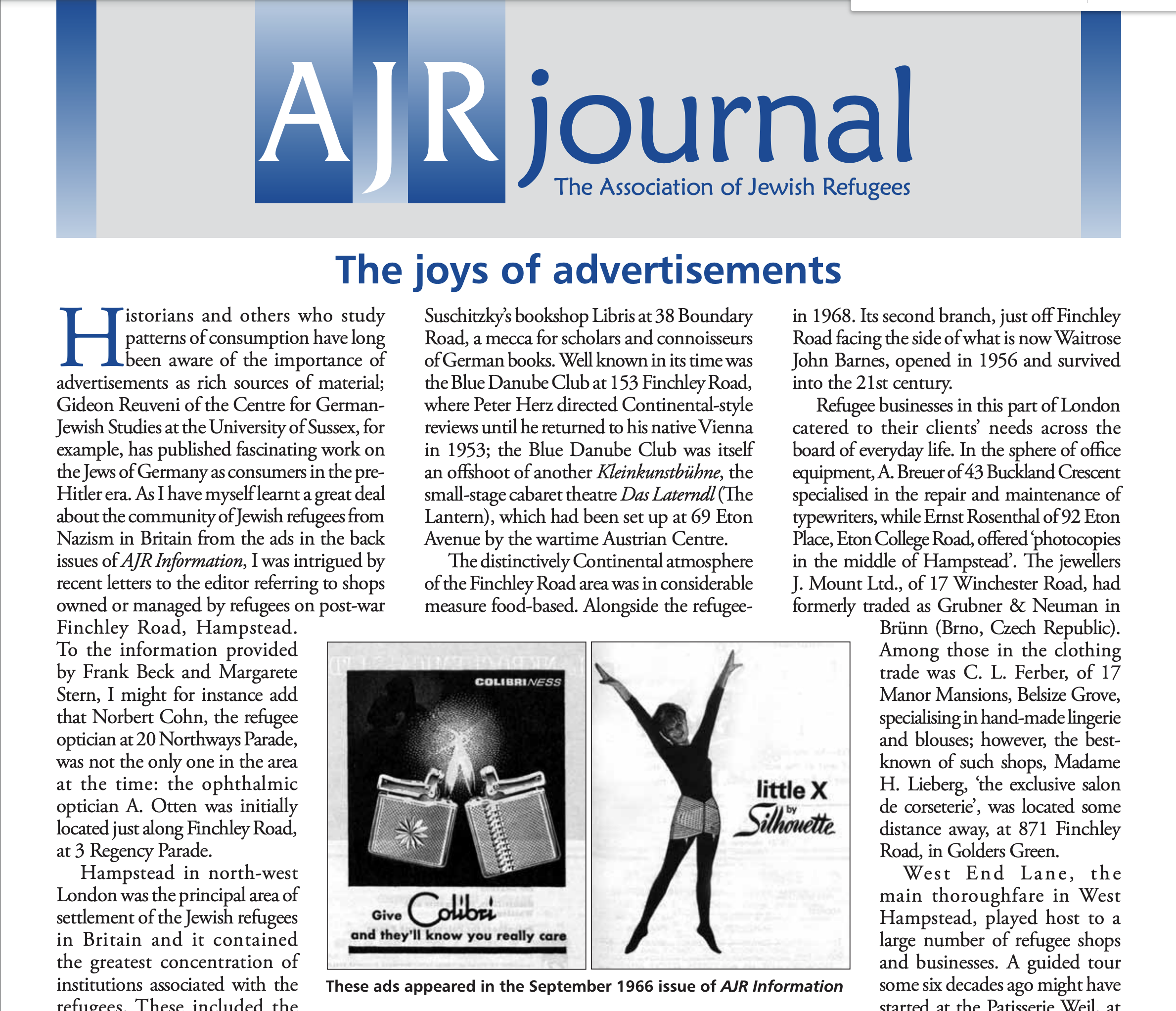The German Jewish refugee community in Hampstead
In 2015, the AJR Journal of the Association of Jewish Refugees of Great Britain, offered a fascinating look at the history of the postwar Jewish refugee settlement in Hampstead, London through a review of advertisements for refugee businesses that ran in its own pages in the 1940s and later. Following is an excerpt, and here you can read the full article. .
Hampstead in north-west London was the principal area of settlement of the Jewish refugees in Britain and it contained the greatest concentration of institutions associated with the refugees. These included the Freud Museum at 20 Maresfield Gardens (previously Sigmund Freud’s last home); Belsize Square Synagogue (previously the New Liberal Jewish Congregation); the four offices occupied by the AJR until it decamped to Stanmore (at 279a Finchley Road, its founding address in 1941, from 1943 at 8 Fairfax Mansions, then at 9 Adamson Road, and finally at 1 Hampstead Gate, Frognal); and Otto Schiff House at 14 Netherhall Gardens, the first of the homes built in London for elderly refugees and jointly administered by the Central British Fund and the AJR.
Commercial enterprises founded by refugees also proliferated in this area, the best known being the Cosmo restaurant and café on Northways Parade. Many of the others advertised in AJR Information, for example the Dorice, another restaurant popular among refugees, located opposite the Cosmo at 169a Finchley Road, and Joseph Suschitzky’s bookshop Libris at 38 Boundary Road, a mecca for scholars and connoisseurs of German books. Well known in its time was the Blue Danube Club at 153 Finchley Road, where Peter Herz directed Continental-style reviews until he returned to his native Vienna in 1953; the Blue Danube Club was itself an offshoot of another Kleinkunstbühne, the small-stage cabaret theatre Das Laterndl (The Lantern), which had been set up at 69 Eton Avenue by the wartime Austrian Centre.
The German Jewish refugee community in Hampstead
In 2015, the AJR Journal of the Association of Jewish Refugees of Great Britain, offered a fascinating look at the history of the postwar Jewish refugee settlement in Hampstead, London through a review of advertisements for refugee businesses that ran in its own pages in the 1940s and later. Following is an excerpt, and here you can read the full article. .
Hampstead in north-west London was the principal area of settlement of the Jewish refugees in Britain and it contained the greatest concentration of institutions associated with the refugees. These included the Freud Museum at 20 Maresfield Gardens (previously Sigmund Freud’s last home); Belsize Square Synagogue (previously the New Liberal Jewish Congregation); the four offices occupied by the AJR until it decamped to Stanmore (at 279a Finchley Road, its founding address in 1941, from 1943 at 8 Fairfax Mansions, then at 9 Adamson Road, and finally at 1 Hampstead Gate, Frognal); and Otto Schiff House at 14 Netherhall Gardens, the first of the homes built in London for elderly refugees and jointly administered by the Central British Fund and the AJR.
Commercial enterprises founded by refugees also proliferated in this area, the best known being the Cosmo restaurant and café on Northways Parade. Many of the others advertised in AJR Information, for example the Dorice, another restaurant popular among refugees, located opposite the Cosmo at 169a Finchley Road, and Joseph Suschitzky’s bookshop Libris at 38 Boundary Road, a mecca for scholars and connoisseurs of German books. Well known in its time was the Blue Danube Club at 153 Finchley Road, where Peter Herz directed Continental-style reviews until he returned to his native Vienna in 1953; the Blue Danube Club was itself an offshoot of another Kleinkunstbühne, the small-stage cabaret theatre Das Laterndl (The Lantern), which had been set up at 69 Eton Avenue by the wartime Austrian Centre.

